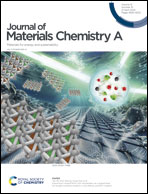Energy-efficient UV-to-NIR active smart electrochromic tetrabenzofluorene molecules†
Abstract
Electrochromic (EC) smart windows are considered a profitable energy conservation technology in residential and commercial buildings. These windows can dynamically adjust their opacity or tint in response to external factors such as temperature, sunlight, or user input. External bias produces charged species capable of absorbing light in the electromagnetic spectrum, eventually regulating heating, cooling, and lighting inside buildings. Another fundamental property of EC devices is their ability to store charge from input currents. Here, three new classes of tetrabenzofluorene derivatives are reported, which show excellent EC properties in terms of EC contrast (40–50%), coloration efficiency (above 100 cm2 C−1), and response time (5 s). Furthermore, EC devices function in three states: solid, solution, and gel states, and can also store the applied charge proficiently. The devices showed excellent cycling stability (300 cycles), capacity retention (95–100%), and moderately slow discharging; i.e., the solid-state device produced an open circuit potential close to 1.2 V and discharged to 0.6 V in 2000 s. Moreover, the charging and discharging process can be monitored visually by the change in color of the EC material. The design strategy, synthesis, detailed optical, electrochromic, and spectroelectrochemical characterization, proof-of-concept smart window fabrication, and energy storage studies are presented.



 Please wait while we load your content...
Please wait while we load your content...